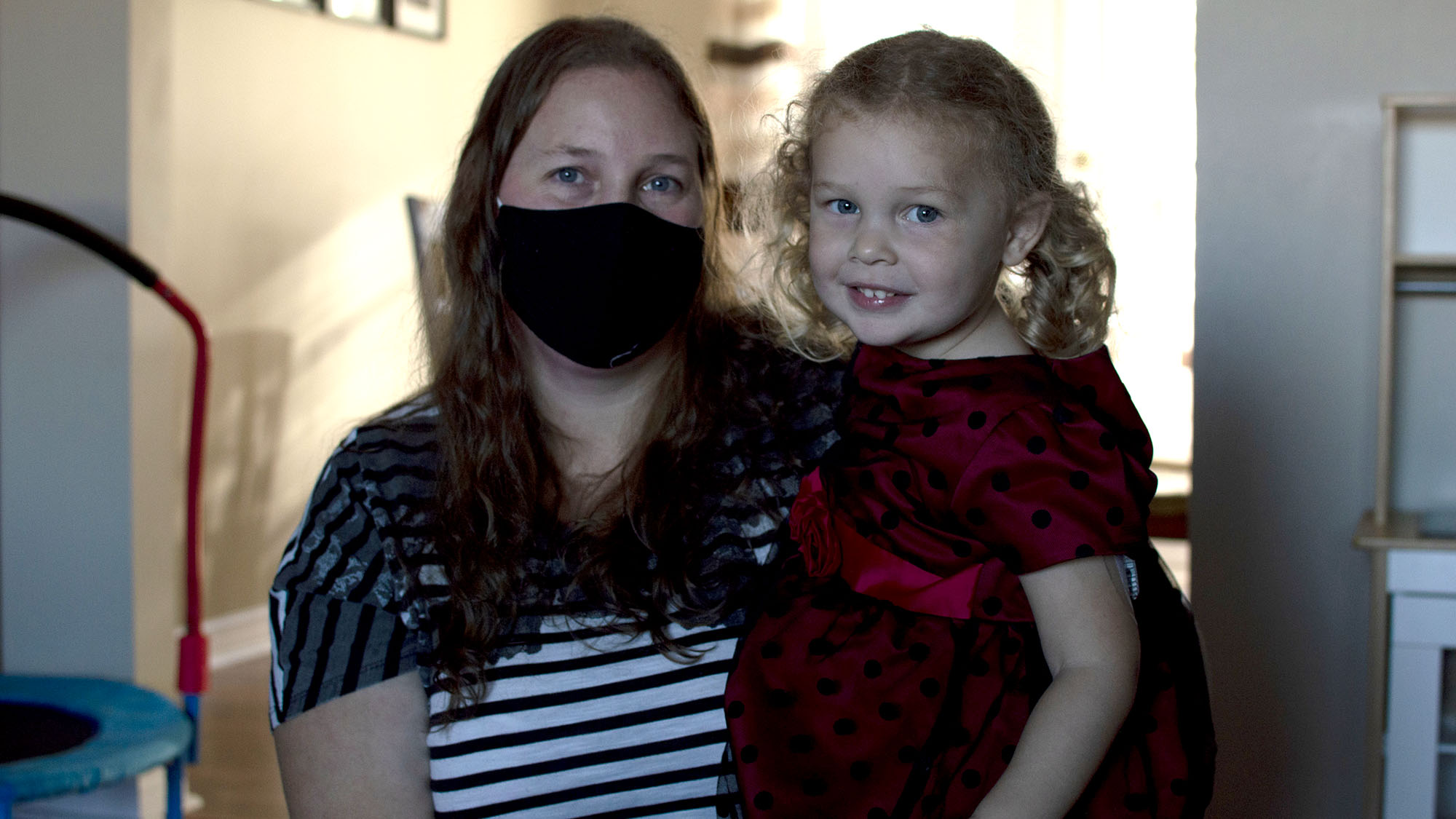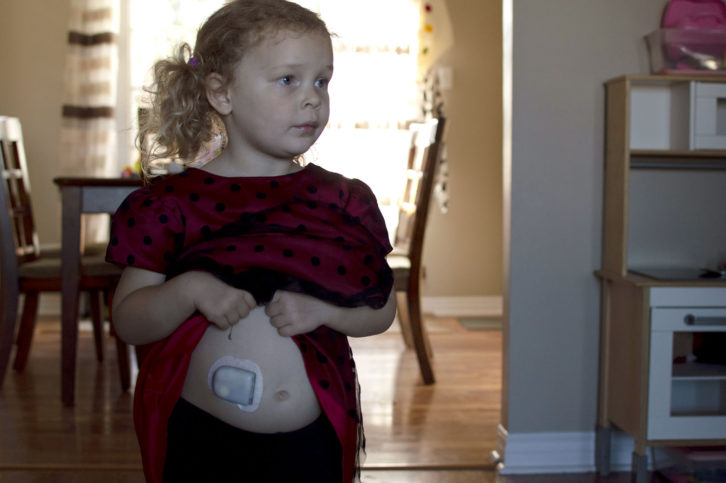Nova Scotia moms fight for provincial coverage of continuous glucose monitors
One mother advocating for her diabetic daughter feels ‘led on’ by Premier Tim Houston

caption
Dena Keating, left, holds daughter Hannah on Nov. 20.Three-year-old Hannah Keating needs a continuous glucose monitor to survive.
Hannah has been a Type 1 diabetic for half her life. Her continuous glucose monitor (CGM) works simultaneously with her insulin pump.
“It changed everything,” Hannah’s mom, Dena Keating, said.
After a few weeks of using her CGM, Hannah told Keating, “Mommy, my blood sugars are really, really good,” and gave her a thumbs-up, Keating said.
Without the monitor, Hannah would have to draw blood from her finger on average 10 times a day.

caption
Hannah Keating shows off her Omnipod insulin pump on Nov. 20. The pump works in tandem with her continuous glucose monitor.Keating said Hannah doesn’t feel her low blood sugars. Hannah and her mom rely on her CGM to alert them when her blood sugar levels drop.
If not treated quickly enough, low blood sugars can cause seizures, unconsciousness, and even death for diabetics.
Type 1 diabetics use CGMs to track blood glucose levels 24 hours a day, seven days a week. The technology is clinically proven to help people living with diabetes stay in their target blood sugar range.
CGMs should be used as an “essential part of diabetes self-management,” according to a recent study published in July by the Canadian Journal of Diabetes and Diabetes Canada.
“In the short term, it’s really about helping people have that capacity to live a bit more of an organic life, of a less totally rigid, structured way of living,” said Brooks Roche, virtual diabetes education specialist for Diabetes Canada.
“The impacts on quality of life are just enormous.”
As many as 11,300 other Nova Scotians are living with Type 1 diabetes, just like Hannah, according to statistics from Diabetes Canada.

caption
Hannah’s blood sugar is always displayed on Dena Keating’s cellphone, which is connected to the little girl’s continuous glucose monitor.While some diabetic supplies are partially covered under the Nova Scotia Insulin Pump Program, eligibility for the program is restricted, based on age and income.
But Nova Scotia’s provincial health-care plan doesn’t cover the cost of continuous glucose monitors for any diabetics.
For families without private insurance, Diabetes Canada estimates that CGMs can cost anywhere between $3,000 and $6,000 per year. That’s as much as 10 per cent of the median income for Nova Scotians.
Hannah has insurance that covers her CGM, but not every diabetic is so lucky.
Financial burden
Samantha Publicover and her 12-year-old daughter, Harley, rely on a CGM to manage her diabetes. Publicover’s insurance doesn’t cover it.
“It’s a disease for the rich,” Publicover said.
With the family already living paycheque to paycheque, the additional $300 a month for Harley’s CGM is an added financial burden.
“If you talk to my 12-year-old daughter, she would tell you she doesn't feel safe if she's not wearing the Dexcom,” Publicover said, referring to one of the companies that sells the monitors.
“I have to make sure she has it. I have to make sure she feels safe.”
According to Dexcom, British Columbia, Yukon and Quebec are the only provinces that fully cover the cost of CGM for Type 1 diabetics of any age.
Saskatchewan and Manitoba fully cover the cost of CGM, but only up to ages 18 and 25, respectively.
Ontario covers the cost of CGM for those eligible for the Ontario Disability Support Program: those over the age of 18 and in financial need, which a caseworker determines.
“The Atlantic provinces are far behind on the standard of care that we’re providing through public programs,” Roche, the Diabetes Canada specialist, said.
Premier Houston and the finger prick challenge
Hoping to raise awareness of the astronomical costs of diabetes supplies in Nova Scotia, Keating and Publicover created an advocacy Facebook page in July.
In August, the moms used their Facebook page to organize the Nova Scotia Finger Prick Challenge. The challenge dared people without diabetes to check their blood sugar levels throughout the day using a basic glucose meter.
Basic glucose meters work by pricking the fingertip with a needle to get a drop of blood.
While Tim Houston was running in the provincial election campaign, he participated in the challenge. In a social media post, Houston said that he now recognizes the struggles that diabetics face every day.
Afterwards, Publicover said she spoke to Houston on the phone twice and that he seemed interested and wanted to help the cause. After the calls, Publicover told Keating that she “had such a good feeling about this.”
After Houston was elected and became premier, Publicover emailed him inquiring about the status of CGM coverage under the provincial pharmacare program.
Natalie Borden, the government's executive director of pharmaceutical services and extended benefits, responded to Publicover on Houston’s behalf in an email dated Sept. 22.
“Continuous and flash glucose monitoring systems represent a potentially significant financial investment of health care system funding. Therefore, their role in the health system in Nova Scotia needs to be carefully considered,” Borden wrote.
“We are reviewing this technology utilizing clinical information from the Canadian Agency for Drugs and Technology in Health (CADTH) and considering cost implications.”
The agency, which advises Canadian governments on drugs and medical devices, opposes Diabetes Canada’s study that proved the effectiveness of CGMs for Type 1 diabetics.
The Signal asked the Department of Health and Wellness about the future of provincial coverage for CGMs. Department spokesperson Marla MacInnis provided a statement that was almost identical to the email Publicover received from Borden.
Publicover said she was disappointed by the response.
“It felt like we were being led on,” she said.
Two weeks ago, Houston’s Facebook page shared a post in recognition of Diabetes Awareness Month.
The post tagged Keating and Publicover’s Facebook page.
“I recently had the opportunity to participate in the NS Finger Prick Challenge, organized by Emergency Diabetes Support for Nova Scotians, and it was truly eye-opening,” Houston said in the Nov. 14 post.
“He said everything we wanted to hear when he was trying to get in because he wanted our vote,” Publicover said. “I understand that, but I did think he really understood what we needed.”
The Signal asked Houston to address Publicover's claims.
Catherine Klimek, spokesperson for the premier, responded saying the government is looking at the whole health-care system.
"Government is reviewing the monitors to see if they fit into the Pharmacare Program," Klimek wrote in an emailed statement.
"We committed to looking at this issue, but no decision has been made. We cannot commit to add them without this important review."
About the author

Hannah Bryenton
Hannah is a reporter for The Signal at the University of King's College. She is from Prince Edward Island and is currently finishing her Bachelor...
J
Jett
M
MaryElizabeth
J
Jennifer
C
Christine